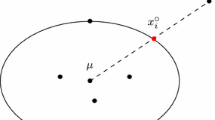Abstract
Threshold methods for multivariate extreme values are based on the use of asymptotically justified approximations of both the marginal distributions and the dependence structure in the joint tail. Models derived from these approximations are fitted to a region of the observed joint tail which is determined by suitably chosen high thresholds. A drawback of the existing methods is the necessity for the same thresholds to be taken for the convergence of both marginal and dependence aspects, which can result in inefficient estimation. In this paper an extension of the existing models, which removes this constraint, is proposed. The resulting model is semi-parametric and requires computationally intensive techniques for likelihood evaluation. The methods are illustrated using a coastal engineering application.
Similar content being viewed by others
References
Bishop, Y. M., Fienberg, S. and Holland, P. (1975) Discrete Multivariate Analysis, MIT Press, Cambridge, MA.
Coles, S. G. (1990) Discussion of paper by A. C. Davison and R. L. Smith. Journal of the Royal Statistical Society B, 52, 429–430.
Coles, S. G. and Tawn, J. A. (1991) Modelling extreme multivariate events. Journal of the Royal Statistical Society B, 53, 377–392.
Coles, S. G. and Tawn, J. A. (1994) Statistical methods for multivariate extremes: an application to structural design (with discussion). Applied Statistics, 43, 1–48.
Coles, S. G., Tawn, J. A. and Smith, R. L. (1994) A seasonal Markov model for extremely low temperatures. To appear in Environmetrics.
Csiszar, L. (1975) I-divergence geometry of probability distributions and minimisation problems. Annals of Probability, 3, o146–158.
Davison, A. C. and Smith, R. L. (1990) Models for exceedances over high thresholds (with discussion). Journal of Royal Statistical Society B, 52, 393–442.
de Haan, L. (1985) Extremes in higher dimensions: the model and some statistics. Proc. 45th Sess. I.S.L., paper 26.3.
Dixon, M. J. (1994) Discussion of paper by S. G. Coles and J. A. Tawn. Applied Statistics, 43, 38–39.
Gnedenko, B. V. (1943) Sur la distribution limite du terme maximum d'une serie aleatoire. Annals of Mathematics, 44, 423–453.
Joe, J., Smith, R. L. and Weissman, I. (1992) Bivariate threshold methods for extremes. Journal of the Royal Statistical Society B, 54, 171–183.
Kullback, S. (1968) Probability densities with given marginal. Annals of Mathematical Statistics, 39, 1236–1243.
Ledford, A. and Tawn, J. A. (1994) Statistics for near independence in multivariate extreme values. Submitted.
Pickands, J. (1975) Statistical inference using extreme order statistics. Annals of Statistics, 3, 119–131.
Resnick, S. I. (1987) Extreme Values, Regular Variation, and Point Processes, Springer-Verlag, New York.
Shi, D., Smith, R. L. and Coles, S. G. (1994) Joint versus marginal estimation for bivariate extremes. Submitted.
Smith, R. L. (1982) Uniform rates of convergence in extreme value theory. Advances in Applied Probability, 14, 600–622.
Smith, R. L. (1989) Extreme value analysis of environmental time series: an application to trend detection in ground level ozone. Statistical Science, 4, 367–393.
Smith, R. L., Tawn, J. A. and Coles, S. G. (1994) Markov chain models for threshold exceedances. Submitted.
Tawn, J. A. (1988) Bivariate extreme value theory: models and estimation. Biometrika, 75, 397–415.
Whittaker, J. (1990) Graphical Models in Applied Multivariate Statistics, Wiley, Chichester.
Author information
Authors and Affiliations
Rights and permissions
About this article
Cite this article
Dixon, M.J., Tawn, J.A. A semi-parametric model for multivariate extreme values. Stat Comput 5, 215–225 (1995). https://doi.org/10.1007/BF00142663
Issue Date:
DOI: https://doi.org/10.1007/BF00142663



